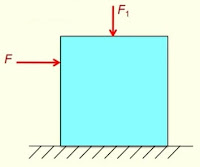We were discussing the importance of friction i.e. positive and negative effects of friction with the help of our previous
post.
Let us start here with the classifications of friction.
Now, we will be interested further to understand the classifications
of friction with the help of this post i.e. explain the different types of friction in detail. We will find out here the
classifications of friction and will also brief here each type of friction in
this post.
Let us start here with the classifications of friction.
Classifications of friction
We will classify the friction as mentioned
below.
Fig: 1- Classification of friction
External friction
External friction is basically defined as the friction
due to the interaction between surfaces of two solid bodies in contact.
External friction will be further classified in two
types of friction as mentioned below.
- Static friction
- Dynamic friction
Static friction
Static friction will come in to picture when surfaces
of two solid bodies in contact are at rest but there is tendency for a relative
motion.
Dynamic friction
Dynamic friction will come in to picture when surfaces
of two solid bodies in contact are in relative motion.
Internal friction
Internal friction will be further classified in two
types of friction as mentioned below.
- Fluid friction
- Solid friction
Fluid friction
Fluid friction is also termed as viscous friction.
Fluid friction is basically developed between fluid
elements when adjacent fluid layers are moving with different velocities.
Frictional force developed here will be proportional
to the relative velocity between the fluid layers and the fluid viscosity.
Fluid friction concept will be widely used in the
problems based on flow through pipes and orifices, bodies immersed in fluids
and lubricated surfaces.
Solid friction
Solid friction will be found in all type of solid
materials subjected to cyclic loading. Energy will be dissipated internally
within the material.
Frictional force due to solid friction will be
proportional to the displacement.
Let us see here one more type of friction i.e. Dry
friction
Dry friction
Let us assume that a block, as mentioned in following
figure, is subjected with a force F1.
Fig: 2- Block stationary at the surface
Now we need to ask to our self that whether there will
be frictional force over here or not. We can easily say that there will not be
any friction and hence frictional force in above situation.
Because, no frictional force will be developed in the
absence of an external force to cause a tendency for relative motion. That
means if there will not be any force acting on a body that causes the tendency
for relative motion, there will be no frictional force.
If we consider that only force F1 is acting
on the body which is displayed above, there will be no frictional force as
there will be no tendency for a relative motion between body and surface over
which body is placed.
If we consider the pushing force F is acting on the
body, frictional force will be started to develop at the interface of the
objects.
Force F will be balanced by the frictional force and hence
the object will remain in equilibrium and at the rest condition.
When we will increase the pushing force F, frictional
force will also be increasing to maintain the equilibrium condition of the
body. When pushing force F will reach to the maximum frictional force, the
object will be on the verge of sliding i.e. if force F will be increased even slightly
more than the maximum value of frictional force, object will start to move or
slide.
We can see it in following figure left part, we can
see the curve drawn between the applied force and the frictional force developed
while body is in rest condition here. Frictional force fs (static
frictional force) will be increasing linearly with the pushing force F. The
body will remain in stationary condition up to a point where pushing force reaches
to the maximum value of frictional force.
Fig 3- Frictional force Vs Applied force
The first part of above figure shows the curve between
the friction force and applied pushing force while body is in rest condition.
The right part of the above figure shows the curve between
the friction force and the applied force while body is in rest condition. When pushing
force F will reach to the maximum frictional force, the object will be on the
verge of sliding i.e. if force F will be increased even slightly more than the maximum
value of frictional force, object will start to move or slide.
We must have to note it here that the frictional force
will be dropped when movement will be started and further it will be
independent of relative velocity up to a limit and beyond that frictional force
will be dropped again as displayed here in the right part of the above figure.
Therefore, we have studied here the various types of
friction and frictional force with the help of this post. We have also
introduced here the term dry friction and we have also understood here the
importance of static friction and dynamic friction with the curve drawn between
the applied force and friction force.
Do you have any suggestions? Please write in
comment box and also drop your email id in the given mail box which is given at
right hand side of page for further and continuous update from www.hkdivedi.com.
We will find out now the coulomb's law of dry friction
in our next post.
Reference:
Engineering Mechanics, By Prof K. Ramesh
Image courtesy: Google















No comments:
Post a Comment